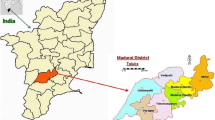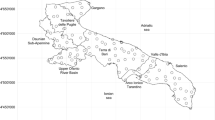Abstract
Drought is one of the main natural hazards affecting the economy and the environment of large areas. Droughts cause crop losses, urban water supply shortages, social alarm, degradation and desertification. In this study, the spatial characteristics of annual and seasonal drought were evaluated based on climate data from 16 synoptic stations during the period of 1980–2010 in south of Iran. To estimate the drought severity used modified Reconnaissance Drought Index (RDI) and to prepare maps, ArcGis10.2 software was used. Results showed in annual drought, percent of areas with normal condition, severe dry and extreme dry condition have had significant increasing trend (0.95 level). In winter drought, the percentage of areas with severe dry and extreme dry condition have had significant increasing trend (0.95 level). In spring drought, percent of areas with moderate dry has had significant increasing trend (0.95 level), in summer drought, percent of areas with moderate dry has had increasing trend (insignificant) and in autumn drought, percent of areas with severe dry has had significant increasing trend (0.95 level). Other classes of drought in different time scales had not significant trend. Result showed that the percentage of area with dry condition is increasing, this can be effective on the agricultural activities, agricultural productions, water resource management and other activities.











Similar content being viewed by others
References
Allen, R.G., Pereira, L.S., Raes, D., Smith, M (1998) Crop Evapotranspiration. Guidelines for Computing Crop Water Requirements. FAO Irrigation and Drainage Paper 56, Roma, Italy
American meteorological society (2004) Statement on meteorological drought. Bull Am Meteorol Soc 85:771–773
Asgar H, Mohsenipour M, Shahid H, Hadipour S, Shafieifar M, Roushenas P (2014) Spatio-temporal characteristics of drought and trends of drought in Qazvin province of Iran. Research jJournal of aApplied sSciences. Eng TechnolEngineering and Technology 8(11):1299–1311
Azarakhshi M, Mahdavi M, Arzani H, Ahmadi H (2011) Assessment of the palmer drought severity index in arid and semi-arid rangeland: (case study: Qom province, Iran). Desert 16:77–85
Bao Y, Meng C, Shen S, Qiu X, Gao P, Liu C (2011) Temporal and spatial patterns of droughts for recent 50 years in Jiangsu based on meteorological drought composite index. Acta Geograph Sin 66(5)):599–608
Bazrafshan J, Khalili A (2013) Spatial analysis of meteorological drought in Iran from 1965 to 2003. Desert 18:63–71
Byun HR, Wilhite DA (1996) Daily quantification of drought severity and duration. J Clim 5:1181–1201
Dastorani MT, Afkhami H (2011) Application of artificial neural networks on drought prediction in Yazd (Central Iran). Desert 16:39–48
Dracup JA, Lee KS, Paulson EG (1980) On the definition of droughts. Water Resour Res 16:297–302
Guttmann NB (1998) Comparing the palmer drought index and the standardized precipitation index. J Am Water Resour Assoc 34:113–121
Kallis G (2008) Droughts. Annu Rev Environ Resour 33:85–118
Kao SC, Rao SG (2008) Reply to comment by T. P. Hutchinson on Trivariate statistical analysis of extreme rainfall events via the Plackett family of copulas. Water Resour Res 44(2):32–37
Kohler MA (1949) Double-mass analysis for testing the consistency of records and for making adjustments. Bull Am Meteorology Soc 30:188–189
Komuscu AU (1999) Using the SPI to analyze spatial and temporal patterns of drought in Turkey. Drought network news 11:7–13
Kousari MR, Ahani H (2012) An investigation on reference crop evapotranspiration trend for 1975 to 2005 in Iran. Int J Climatol 32:2387–2402
Lana X, Serra C, Burgueno A (2001) Patterns of monthly rainfall shortage and excess in terms of the standardized precipitation index for Catalonia (NE Spain). Int J Climatol 21:1669–1691
Liu XY, Li DL, Wang JS (2012) Spatiotemporal characteristics of drought over China during 1961–2009. J Desert Res 32:473–483
Mahdavi, M (2002) Applied hydrology. Tehran university press, Iran.
Masoudi, M (2010) Risk assessment and remedial measures of land degradation, in parts of southern Iran, Lambert Academic Publishing, Germany, P: 220.
Masoudi M, Hakimi S (2014) A new model for vulnerability assessment of drought in Iran using percent of normal precipitation index (PNPI). Iran J Sci Technol 38(4):435–440
Mirzavand M, Ghazavi R (2015) A stochastic modeling technique for groundwater level forecasting in an arid environment using time series methods. Water Resour Manag. doi:10.1007/s11269-014-0875-9
Nohegar N, Heydarzadeh M, Malekian A (2013) Assessment of severity of droughts using Geostatistics method, (case study: southern Iran). Desert 18:79–87
Tsakiris G (2004) Meteorological Drought Assessment. Paper prepared for the needs of the European Research Program MEDROPLAN (Mediterranean Drought Preparedness and Mitigation Planning), Zaragoza. Spain
Tsakiris G, Vangelis H (2005) Establishing a drought index incorporating evapotranspiration. Eur Water 9(10):3–11
Tsakiris G, Rossi G, Iglesias A, Tsiourtis N, Garrote L, Cancelliere A (2006) Drought indicators report. Report made for the needs of the European Research Program MEDROPLAN (Mediterranean Drought Preparedness and Mitigation Planning)
Tsakiris G, Pangalou D, Tigkas D, Vangelis H (2007a) Assessing the areal extent of drought. Water resources management: new approaches and technologies, European water resources association, Chania, Crete -Greece, 14–16 June
Tsakiris G, Pangalou D, Vangelis H (2007b) Regional drought assessment based on the reconnaissance drought index (RDI). Water Resoure Manag 21(5):821–833
Tsakiris G, Nalbantis I, Pangalou D, Tigkas D, Vangelis H (2008) Drought meteorological monitoring network design for the reconnaissance drought index (RDI), 1st international conference “drought management: scientific and technological innovations”. Zaragoza – Spain
Tsakiris G, Nalbantis I, Cavadias G (2011) Regionalization of low flows based on canonical correlation analysis. Adv Water Resour 34:865–872
Tsakiris G, Nalbantis I, Vangelis H, Verbeiren B, Huysmans M, Tychon B, Jacquemin I, Canters F, Vanderhaegen S, Engelen G, Poelmans L, Becker P, Batelaan O (2013) A system-based paradigm of drought analysis for operational management. Water Resour Manag 27:5281–5297
Vangelis H, Tigkas D, Tsakiris G (2013) The effect of PET method on reconnaissance drought index (RDI) calculation. J Arid Environ 88:130–140
Wilhite DA, Glantz MH (1985) Understanding the drought phenomenon: the role of definitions. Water Int 10(3):111–120
Wilhite DA, Hayes MJ, Svodoba MD (2000) Drought monitoring and assessment in the U.S. In: Voght JV, Somma F (eds) Drought and drought mitigation in Europe. Kluwers, Dordrecht
Zarei R, Sarajian M, Bazgeer S (2013) Monitoring meteorological drought in Iran using remote sensing and drought indices. Desert 18:89–97
Zareiee AR (2014) Evaluation of changes in different climates of Iran, using de Martonne index and Mann- Kendall trend test. Nat Hazards Earth Sys Sci 12(2)):2245–2261
Zareiee AR, Masoudi M, Mahmodi AR (2013) Analyzing spatial pattern of drought changes in Iran, using standardized percipetation index (SPI). J Ecol, Environ Conserv 20(2)):427–432
Zehtabian GR, Karimi K, Nakhaee Nezhadfard S, Mirdashtvan M, Khosravi H (2013) Comparability analyses of the SPI and RDI meteorological drought indices in South Khorasan province in Iran. Int J Adv Biol Biomed Res 9:981–992
Acknowledgments
We would like to thank meteorological organization and water organization of Iran for provides thes necessary data.
Author information
Authors and Affiliations
Corresponding author
Rights and permissions
About this article
Cite this article
Zarei, A.R., Moghimi, M.M. & Mahmoudi, M.R. Analysis of Changes in Spatial Pattern of Drought Using RDI Index in south of Iran. Water Resour Manage 30, 3723–3743 (2016). https://doi.org/10.1007/s11269-016-1380-0
Received:
Accepted:
Published:
Issue Date:
DOI: https://doi.org/10.1007/s11269-016-1380-0




